After publishing the first Sandy Bridge Xeon review of the E3-1220 a big question remained, what would the performance of hyper-threaded versions of the new Intel Xeon E3 series be like, including the Intel Xeon E3-1230? Today, we look at the next step faster Intel Xeon E3 CPU. The basic enhancements are the addition of Hyper-Threading and a 100MHz increase (3.2%) in base clock speed and a 200MHz increase (5.9%) in Turbo clocks over the Xeon E3-1230. Like the E3-1220, the E3-1230 has an 80w TDP, AES-NI, ECC support, VT-x and VT-d support and a host of other desirable features for the server market.
Just to give readers perspective on the lineup, here is the February 2011 (pushed to April 2011 thanks to the Cougar Point bug) Intel Xeon E3-1200 series launch line-up with the E3-1230 included:

A quick note, C200 series motherboards are still under NDA/ embargo at the time of this writing (March 2011), so that is probably the reason for the lack of reviews on other site. One advantage of purchasing much of the hardware reviewed on this site is that it does not fall under NDA.
CPU-Z does not properly recognize the Intel Xeon E3-1230 at this point so consider this a CPU performance preview.
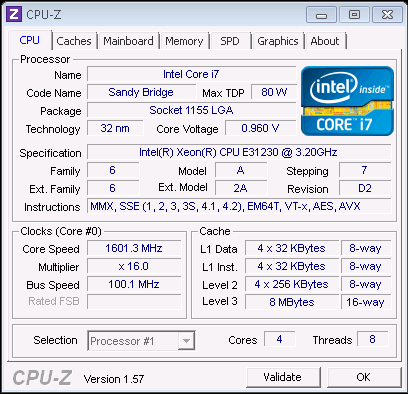
Ed. 14 March 2011: It does appear that Intel has pulled the E3-1200 family from channels where quite a few people have received the chips lately. After speaking with Intel, it seems as though the early release of the few chips was due to a distributor mix up resulting in a premature release. The Xeon E3 series has not been released, which is why as of March 14 there is no information on Intel’s site, yet but I expect more information to be forthcoming in the near future. Being clear, the Xeon E3 chips have not launched yet and that is the reason for their unavailability.
Test Configuration
Finally being able to post power consumption numbers on a proper platform is important because IPMI 2.0 and KVM-over-IP are becoming must-have features on new server motherboards. The Supermicro X8SI6-F was one of the most popular motherboards reviewed on this site for the Lynnfield platform as it incorporated a LSI SAS 2008 SAS 2.0/ SATA III 6.0gbps 8-port controller onboard. I therefore used the most similar motherboard I had at launch, the Tyan S5512WGM2NR to perform the testing.
- CPU: Intel Xeon E3-1230
- Motherboard: Tyan S5512WGM2NR
- Memory: 8GB 1333MHz CL9 DDR3 (4x2GB)
- OS Drive: OCZ Agility 2 120GB
- Additional NICs: Intel Gigabit CT PCIe x1 network adapter
- Enclosure: Norco RPC-4224
- Power Supply: Seasonic X650 (650w Gold level power supply) PicoPSU 150XT with 150w power supply
The lesson here is that, like previous generations of Intel Xeon CPU’s, the server and desktop parts are interchangeable so long as the socket is correct. I was glad to see the ASUS desktop chip set UEFI is compatible with the new Xeons. CPU-Z identified the quad core Xeon E3-1220 as a Core i3, but the E3-1230 was identified differently.
As we will soon see, the performance is more in-line with the Core i7-2600K on the Xeon E3-1230 part.
Update 5 April 2011: Today Intel announced the IntelXeon E3-1230 CPU, and I am able to publish power consumption numbers using a proper C204 board, a Tyan S5512WGM2NR. I have updated the power consumption numbers herein. I had originally posted the review using a ASUS P8H67-M EVO so the new Intel Xeon E3 series CPUs do work in at least some consumer motherboards which is much better than the LGA 775 and 771 days.
Performance Tests
I have started to use my expanded benchmark suite and am continuing to use this on the plethora of new CPU reviews that I will be doing in the coming weeks. This includes Cinebench R11.5 which is a great multi-threaded benchmark, 7-Zip compression benchmarks, and TrueCrypt encryption benchmarks. For comparison’s sake, I also ran the Lynnfield Xeon X3440 and X3460 through the same battery of tests. I am skipping gaming benchmarks because that is really unnecessary on a server CPU. My personal i7-2600K runs stable at 5.0ghz and was only slightly more expensive, so it is hard to justify using a Xeon for gaming at this point since there is little overclocking potential in the new series of Xeon chips. That is a big departure from the Xeon W35xx W36xx and X34xx series CPUs that were similar to their Core i7 counterparts in terms of FSB overclocking.
Windows Experience Index
Personally, I think that Microsoft’s built-in relative performance indicator, the Windows Experience Index (WEI) does not do enough to stress and stratify CPUs, especially at the upper-end. With that being said, a lot of readers ask for WEI scores so I have learned to oblige.

7.6 CPU score for the Xeon E3-1230 is a bit higher than I expected after the Xeon E3-1220 came in at 7.4. It is the same WEI CPU score as the Core i7-2600K at stock speeds which makes sense given other benchmarks.
Cinebench R11.5
I have been using Cinebench benchmarks for years but have held off using them on ServeTheHome.com because the primary focus of the site until the past few months has been predominantly storage servers. With the expansion of the site’s scope, Cinebench has been added to the test suite because it does represent a valuable benchmark of multi-threaded performance. I have had quite a few readers contact me about this type of performance for things like servers that are Adobe CS5 compute nodes and similar applications. Cinebench R11.5 is something that anyone can run on their Windows machines to get a relative idea of performance.
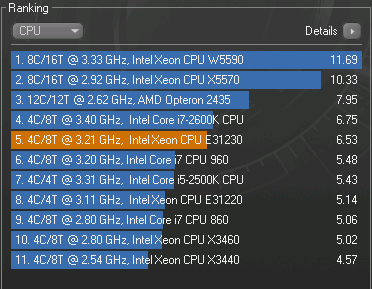
Cinebench responds very well to Hyper-Threading, unlike other tests like Handbrake x264 encoding. The Intel Xeon E3-1230 therefore has a slight clock speed advantage, but the bulk of the difference between it and the Xeon E3-1220 really comes down to Hyper-Threading. This shows the power of the new Sandy Bridge architecture in some workloads as it clearly distances itself from the Xeon E3-1220. Many pure storage related servers will not take advantage of this kind of power so one really needs to look at their own workloads.
7-Zip Compression Benchmark
7-Zip is an immensely popular compression application with an easy to use benchmark.
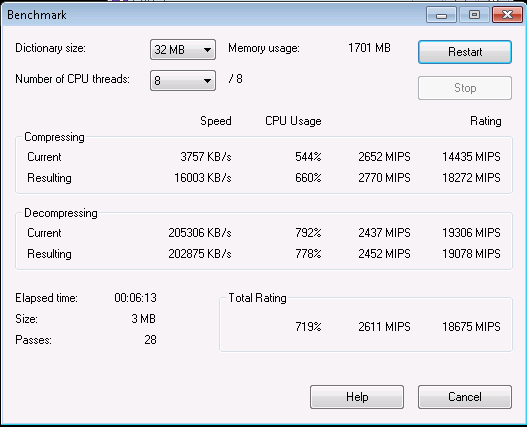
In 7-Zip, the Xeon E3-1230 shows some nice performance gains over the Xeon E3-1220 which is a positive. Also, with Hyper-Threading, the gap is bridged against the older Lynnfield Xeon architecture employed by the Xeon X3440 and X3460 is bridged and surpassed.
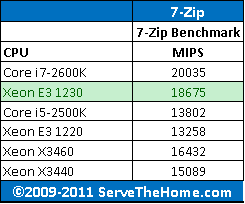
I was a bit surprised in my Xeon E3-1220 review to see 7-Zip take advantage of Hyper-Threading very well as evidenced by the Lynnfield Xeons performing better than the E3-1220. The E3-1230 levels the playing field with healthy performance gains placing it between the Xeon X3460 and Core i7-2600K.
TrueCrypt Encryption Benchmarks
With Intel’s focus on its AES-NI features TrueCrypt can look a bit skewed. Unlike some dubious drivers over the years that were optimized for benchmarks over real world application, Intel’s AES-NI feature does encompass the addition of specialized hardware. This specialized hardware has many practical uses and is becoming more supported. For example, users of Solaris 11 can utilize the AES-NI features to see much higher throughput on encrypted volumes. Without further waiting, here is the Intel Xeon E3-1230 TrueCrypt benchmark run:
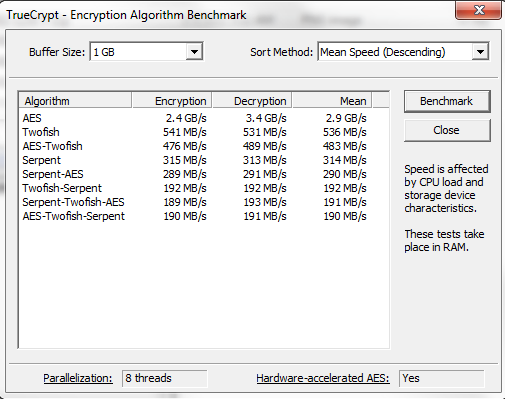
As one can see, the AES benchmark is through the roof. 2.9GB/s is enough to feed the outer edges of more than eighteen modern 3.5″ SATA/ Nearline SAS disks. One can see shots of the Xeon E3-1220, X3440, and X3460 in the Xeon E3-1220 review‘s comparison.

One can see that the new E3-1230’s has become a clear leader in performance across the board which is a positive development for a new cutting edge chip.
As for the AES performance, the above speaks volumes. Sandy Bridge benefits from higher clock speeds and hardware instructions, and Hyper-Threading only extends the lead.
Handbrake 0.9.5 x264 Encoding Benchmarks
As was noted in the Sandy Bridge Reviews, I am moving from DVD quality to Blu-Ray quality encoding with Handbrake this year. During the transition period, I will still have both sets of numbers, however CPUs reviewed previously may not get re-tested for the newer HD test.
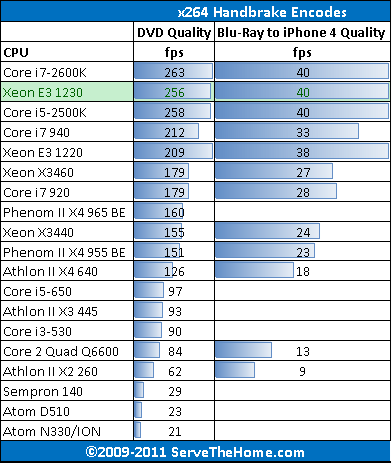
The Xeon E3-1230 is simply fast, really fast. Media encoding performance on the Xeon E3 series outpaces Lynnfield and Bloomfield CPUs, just falling shy of the more expensive desktop Core i7-2600K. Handbrake is known to not take advantage of Hyper-Threading as well as other applications so there is a smaller E3-1220 to E3-1230 performance gain than has been seen in other benchmarks.
As a note, I am not sure why there is a 40fps “cap” on all of these CPUs in the HD run. I am still trying to see if I can get something to run faster.
Power Consumption
Update 5 April 2010, I previously published power consumption figures of the Xeon E3-1200 series CPUs using an Intel H67 based motherboard and discrete GPU because the Bromolow platform had not launched. Today I am able to update the figures using a Tyan S5512WGM2NR C204 based motherboard.
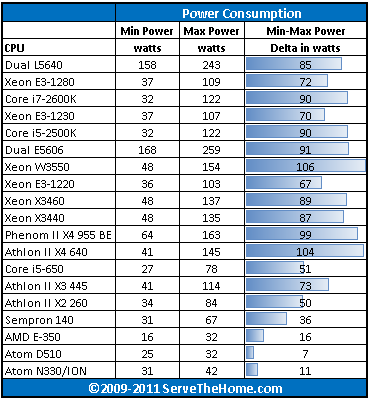
One can note that, like the E3-1220 and E3-1280, the test configuration idled at under 40w at the Windows 7 desktop with a PicoPSU 150XT two 1.5v DDR3 DIMMs, and an OCZ Agility 2 120GB. I went back through previous reviews though and took the min and max numbers I used to generate deltas. Overall, the new chips are pretty awesome in terms of performance/ watt.
Best to think of the above as a relative guide given the platform differences (the N330 uses DDR2 for example) with the above. There are some variations between chips, so actual values may vary a bit even with the same model number due to different default voltages. Although the numbers were in-line with expectations, I will note that I am starting to believe that the E3-1230 sample I have is perhaps a higher-quality bin chip which lead it to be closer to the E3-1220 than the E3-1280.
One again can see the advantages of 80w CPUs. One other factor here is that 32nm 80w CPUs generate less heat than older 45nm counterparts and therefore one needs less fan power to cool them. This differential can be in the 1-2w range depending on the fan used.
Overall, the power consumption of the Xeon E3-1230 series, combined with the tremendous performance and low cost makes it a best buy in the UP server market.
Conclusion
Over the course of benchmarking the Xeon E3-1230 one thing became clear, it is a faster alternative to the Xeon E3-1220. In some instances (particularly those where Hyper-Threading was not a major benefit) the impact was minor. In other instances, it was quite significant. As I stated in the Xeon E3-1220 owners of Lynnfield servers will find very little reason to upgrade unless one is either doing AES encryption on a platform that supports Intel’s AES-NI features or extra CPU speed is holding the server back. Power consumption numbers seem promising and significantly better than previous generation UP server parts at load, especially given the inherent performance of the chips. The price differential between what I paid for the E3-1220 and E3-1230 chips was about $25. Unless one is very price sensitive, I would suggest that the $25 extra is money well spent on the E3-1230 for Hyper-Threading.
Feel free to discuss this article on the new ServeTheHome.com Forums!




